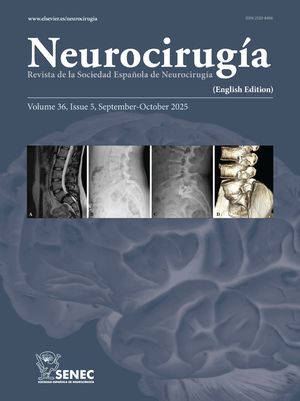La localización menos frecuente de los astrocitomas pilocíticos es la intramedular. Los gliomas representan hasta el 24–30% de los tumores intramedulares en el adulto y son los segundos, sólo tras los ependimomas. La diseminación leptomeníngea a través del líquido cefalorraquídeo es inusual y sucede predominantemente en meduloblastomas, ependimoblastomas, neuroblastomas centrales, ependimomas, tumores de células germinales y gliomas de alto grado. La mayoría de las metástasis secundarias a gliomas medulares publicadas proceden de astrocitomas anaplásicos o glioblastomas multiformes y relativamente pocas de gliomas de bajo grado. La incidencia de diseminación leptomeníngea de gliomas de bajo grado es rara. Publicamos una rara diseminación a las leptomeninges cerebrales de un astrocitoma pilocítico intramedular en el adulto.
Caso clínicoDescribimos un varón de 51 años con masa intramedular recurrente a nivel de C5–C7 intervenido en 4 ocasiones con todos los informes de anatomía patológica describiendo la lesión como astrocitoma pilocítico. 15 años después del diagnóstico desarrolló alucinaciones visuales y deterioro del nivel de conciencia con escala de coma de Glasgow de 13/15. La resonancia magnética mostró importante realce de las leptomeninges y paquimeninges craneales y medulares con intensa afectación de las cisternas basales, espacio subaracnoideo y ambos hemisferios cerebrales sugerente de diseminación leptomeníngea de la masa medular. El paciente falleció a los 3 días.
ConclusiónEste fenómeno es raro y cuando acontece no suele cambiar el comportamiento del tumor primario. En nuestro caso la agresividad se podría justificar o por una malignización del tumor primario no evidenciada debido a la resección parcial de las últimas cirugías o bien a que el tumor en realidad fuese un tumor pilomixoide monomorfo.
The rarest location of pilocytic astrocytoma is intramedullary. Gliomas represent up to 24–30% of intramedullary tumors in adulthood and are second only after ependymomas. Leptomeningeal dissemination through cerebrospinal fluid is unusual and occurs predominantly in medulloblastomas, ependymoblastomas, central neuroblastomas, ependymomas, germ cell tumors and high-grade gliomas. The majority of spinal cord gliomas reporting metastasis were anaplastic astrocytomas or glioblastomas multiforme and relatively few were low-grade gliomas. The incidence of leptomeningeal spread of low-grade tumors is rare. A rare cranial extension of brain leptomeningeal dissemination in an intramedullary pilocytic astrocytoma during adulthood is reported.
Case reportA 51 year-old-man with a recurrent intramedullary mass at C5–C7 level operated 4 times with all pathological anatomy reports describing the lesion as Pilocytic Astrocytoma developed, after 15 years from the diagnosis, visual hallucinations and his level of consciousness worsened to Glasgow coma score 13/15. The MRI showed highly enhanced cranial and spinal leptomeninges and paquimeninges with a micronodular-granulomatous aspect associated with intense affectation of basal cisterns, subarachnoid spaces and convexity of both cerebral hemispheres suggestive of leptomeningeal spread of the spinal mass. The patient expired after three days.
ConclusionLeptomeningeal spread is a rare phenomenon and when it happens usually doesn’t change the primary tumor's behavior. In our case the aggressivenes could be explained by a potential malignization of the primary tumor that it wasn’t documented because of the partial resectionss from the lasts surgeries or instead the tumor was actually a monomorphous pilomyxoid tumor.
Article

If it is the first time you have accessed you can obtain your credentials by contacting Elsevier Spain in suscripciones@elsevier.com or by calling our Customer Service at902 88 87 40 if you are calling from Spain or at +34 932 418 800 (from 9 to 18h., GMT + 1) if you are calling outside of Spain.
If you already have your login data, please click here .
If you have forgotten your password you can you can recover it by clicking here and selecting the option ¿I have forgotten my password¿.






